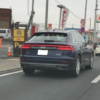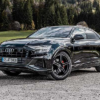2020年モデルとなるフェイスリフト版・アウディ新型「Q7」デビュー!ナゼか超ワイドになったフロントグリル、ヘッドライトも再設計され表情一新!
~待望の新型「Q7」がデビュー!~

アウディのトップグレードSUVモデル「Q7」が、フェイスリフトにより新デザインを得てデビューしました。
今回発表された2020年モデルの新型「Q7」は、過去これまで目撃されてきた開発車両より、前後のデザインが新しく改良され、インテリアにおいても先進性を兼ね備えた変更、そしてパワートレインにおいてはマイルドハイブリッドを採用しています。
~やっぱりフロントグリルは大口化されダイナミック~

まず外観についてですが、フロントのシングルフレームグリルはよりワイドになり、フロントグリルやエアインテークも大口化された再設計デザインとなります。
ボディサイズが大型で車体重量も重く、それでいてエンジンの空冷効率を高めるためにフロントグリルを大口化するというのは、どの自動車メーカでも一つのトレンドファクタになっているようですが、案の定アウディもその流れに沿った設計変更となっています。
またフロントヘッドライトもHDマトリクスLEDユニット(メーカオプション)を搭載した新設計デザインとなり、その輝度も相当に高くなっているとのこと。

こちらはサイドプロファイル。
フロントロアからサイドにかけてのブラックパーツはボディにメリハリが付き、非常にスポーティな仕上がりに。
フェンダーモールのプラスチック部分はかなり最小限に抑えられていますが、反対にプラスチックの占有率が多くなるとチープ感が強調されるのでこれぐらいがちょう良いのかもしれません。
こうしてみると、「Q7」のフロントフェイスも同色素地よりもグリル等のブラックパーツがほとんどを占めるようになりましたね。
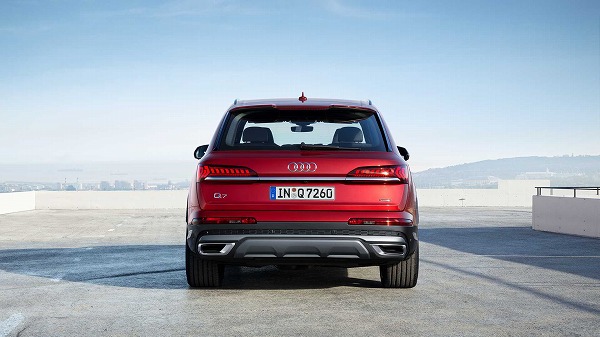
こちらはリヤデザイン。
コチラも新設計のリヤテールランプ下には、クロームストリップを追加することでトップグレードらしい高級感を演出しています。
~インテリアはデジタルパネルをメインとし先進性を強調~
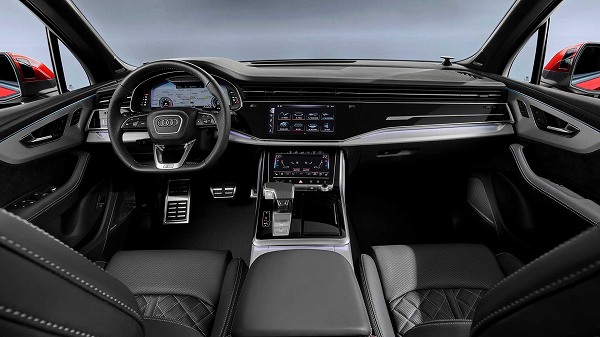
続いてはインテリア。
ダッシュボードは一新し、デュアルタッチスクリーン付となるデジタルレイアウトを採用していますね。
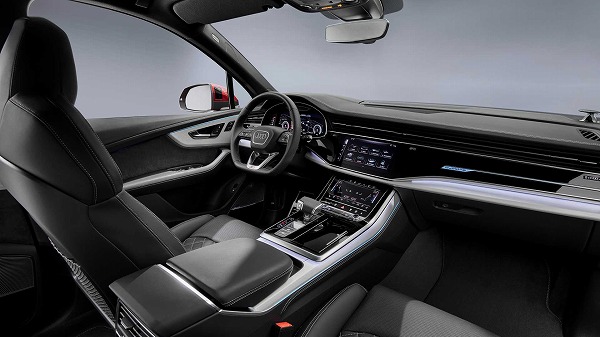
ほとんどのコンポーネンツは前年モデルと非常に良く似たところばかりですが、その一方で先進性を高めるためにMMIナビゲーションやアウディ・コネクトといった技術をしっかりと盛り込み、交通情報からAmazon Alexaへの接続等もしっかりと対応。
リアルタイムにて信号機の情報を認識するCar-to-X通信も搭載されているため、時代に沿った新しい一台となるでしょう。
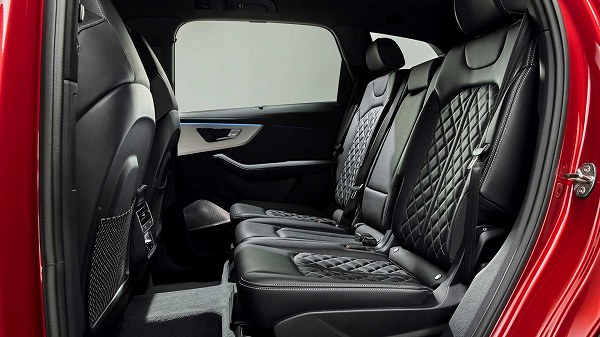
後席はほとんど変わりませんが、やはりトップグレードSUVということもあってフットスペースはもちろんのこと、室内空間はかなり広々としているでしょうね。
~エンジンは全てマイルドハイブリッドを採用。PHVモデルも追加予定~
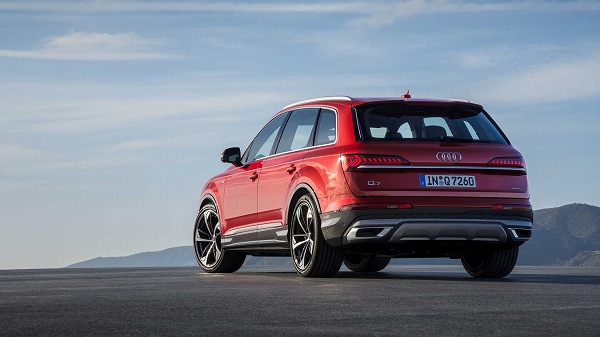
気になるパワートレインについてですが、まずは2種類のディーゼルエンジンモデルが発売される予定で、その後にガソリンエンジンモデルが投入される予定となっています。
詳細についてはまだ明らかにしていませんが、全てのエンジンに48Vのマイルドハイブリッドシステムを搭載するとのこと。
また、PHV(プラグインハイブリッド)モデルもラインナップする計画が有るとのことですが、これに関する詳細は今のところ不明。
価格はまだ発表されていませんが、まずは欧州市場を中心に2019年9月より市場へと投入される予定となっています。
Taken to the next level: new edition of the Audi Q7
The Audi Q7 is getting an all-round update – both visually and technically. The large SUV features the new design of the Q family and offers superb dynamics and excellent comfort, in addition to its superior spaciousness. Mild hybrid technology, the digital operating concept and the optional HD Matrix LED headlights including laser light are just some of its highlights. The new Audi Q7 will be launched in Europe in mid-September.
Robust look: the exterior design
The Audi Q7 demonstrates the hallmark SUV elements in the current design language. It bears the large octagon-shaped Singleframe, with six upright slats providing the structure. As such, the SUV looks even more powerful. The two-part side air inlets have a much more expressive line, just like the sill area that underscores the large SUV’s ground clearance and, in turn, its offroad capabilities. The headlights, optionally in HD Matrix LED technology with Audi laser light, emphasize with their contour and light signature the width of the full-size model. On the restyled rear, a striking chrome strip creates the visual connection between the flat rear lights with their technical-looking graphics and carries forward the horizontal body line. The designers achieved the clear view with taut, flat surfaces, which span the entire width particularly in the license plate region. The Audi Q7 is particularly striking with the optional S line exterior: A blade in the front bumper, sportily accentuated underbody protection at the rear along with full paint finish and 19-inch wheels come standard.Sporty on-road, powerful off: the suspension
Audi has substantially enhanced the dynamic attributes of the Q7. The electromechanical active roll stabilization is available as an option for the large SUV. Adjustable stabilizers reduce the body movements on uneven roads when driving in a straight line. With a sporty driving style, the focus is on optimum roll compensation – the tendency of the car to lean into the bend is reduced substantially.All-wheel steering is also optionally available: The rear wheels turn by up to 5 degrees in the opposite direction at low speed, which increases agility. On the highway these wheels steer slightly in the same direction to promote stability.
Thanks to the combination of these high-tech systems, the Audi Q7 is extremely maneuverable, precise and agile in urban traffic and on hairpin bends. In contrast, the Q7 behaves as a highly comfortable, poised touring SUV with excellent ride comfort on freeways – particularly in conjunction with the adaptive air suspension. It also provides variable ground clearance and prepares the Audi Q7 with its standard quattro drive for terrain off the beaten track. The appropriate offroad mode can be selected via the Audi drive select dynamic handling system with its seven profiles. Air suspension comes standard on all seven-seater Q7 models. The S line exterior includes the slightly firmer adaptive air suspension sport, which lowers the ride height by 15 millimeters (0.6 in) compared with the regular air suspension system.
Mild hybrid technology standard: the drivetrain
All of the engines in the Audi Q7 are coupled to an eight-speed tiptronic and permanent all‑wheel drive. A choice of two diesel engines will be available at market launch. Shortly after the market introduction in September, a gasoline unit, followed also by a plug-in hybrid model, will join the lineup. The standard mild hybrid technology plays a major part in the efficiency of the engines. In customer operation, this technology can reduce consumption by up to 0.7 liters per 100 kilometers. Its central component, the belt alternator starter (BAS), powers a 48-volt main electrical system in which a compact lithium-ion battery stores the energy. During braking, the BAS can recover up to 8 kW of power and feed it back into the battery. If the driver takes their foot off the accelerator at speeds between 55 and 160 km/h (34.2 and 99.4 mph), the Audi Q7 recuperates energy, rolls in idle or coasts for up to 40 seconds with the engine switched off. The BAS restarts the engine the next time the accelerator is depressed, and does so faster and more gently than a conventional starter. The start‑stop range begins at 22 km/h (13.7 mph).Luxury-class lounge: the interior
Whether with five or seven seats – the Audi Q7 combines immense prestige with practical everyday qualities. Through its new design, the large SUV has now grown eleven millimeters (0.4 in) to 5,063 millimeters (16.6 ft) long. It measures 1,970 millimeters (6.5 ft) wide and 1,741 millimeters (5.7 ft) (including roof aerial) high. The Audi Q7 outdoes its direct competitors with interior length as well as headroom and elbow room in the front and rear. A host of storage compartments, a new compartment in the instrument panel as well as the generous load capacity provide highly functional utility value. Depending on the position of the rear seat backs the luggage compartment on the five-seater version offers between 865 and 2,050 liters (30.5-72.4 cu ft) of capacity – the latter with a flat load area. An electric tailgate is standard; foot-activated gesture control is available as an option. Audi optionally supplies the rear seat bench plus; all three seats can be moved individually fore/aft and the backrest angle adjusted, as well as a third seat row with two electrically lowerable seats.The cockpit architecture harmonizes perfectly with the new, digital operating concept, which incorporates two large touchscreens. They provide haptic and acoustic feedback when clicking on the touch controls. When off, the top display slots almost invisibly into the large black decorative surface. All elements refer logically to one another, from the flat air vent strip to the wide console on the center tunnel.
The optional contour ambient lighting package illuminates the interior in the dark. Comfort equipment options include four-zone automatic air conditioning, a power-assist function to close the doors quietly, the Bang & Olufsen 3D Advanced Sound System and the air quality package with fragrancing and ionizer. Highlights in the seat lineup include the customized contour seats with their numerous adjustment functions and the S sport seats plus, both available with climate control and massage function.
High-end connectivity: Audi connect and assist systems
The MMI navigation plus delivers top-of-the-line connectivity. It features LTE Advanced, a Wi-Fi hotspot, natural voice control and the extensive Audi connect portfolio. The latter ranges from traffic information online, navigation with Google Earth, to the hybrid radio. The cloud-based Amazon voice service Alexa, which is integrated into the MMI operating system, is also new. The same applies to the Car-to-X service traffic light information, which is being rolled out in stages in selected European cities. Interconnection with the city’s infrastructure allows the vehicle to receive information from the central traffic light computer via a server, enabling the driver to select a speed to match the next green-light phase. The all-digital Audi virtual cockpit – and the optional head-up display – provide an individual speed recommendation as well as the remaining time until the next green-light phase if the driver is already waiting at a red light. The system thus contributes to a predictive and efficient driving style and facilitates a steady flow of traffic.The adaptive cruise assist, which combines the functions of adaptive speed assist, traffic jam assist and active lane assist, reduces the driver’s workload – particularly on long journeys. In combination with efficiency assist it brakes and accelerates the Audi Q7 in anticipation of the conditions ahead. The emergency assist is also new: If the driver is inactive, the system brings the car to a stop and initiates protective and rescue measures. This function is active in assisted and manual modes.
☆★☆アウディ関連記事5選はコチラ!☆★☆
Reference:motor1.com



